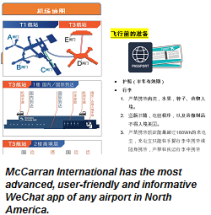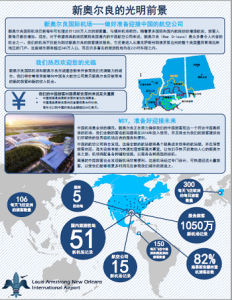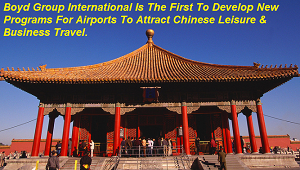Examples of Our China Projects
Boyd Group International is the leader in research, forecasting and trend analysis of China air traffic.
Our Airports:China program monitors traffic and passenger dynamics at over 200 airports across the Middle Kingdom. We monitor events in China via numerous channels, including locally-produced reports in Chinese language. Below are a few of our projects in this area.
Exclusive China-Welcome Programs For Communities & Airports
Boyd Group International’s China Welcome programs provide cutting-edge programs to assist airports, communities and venues in attracting a larger share of the burgeoning Chinese leisure market to the USA.
The programs range from basic digital awareness programs within China, including tailored and locally-registered WeChat apps, to complete wayfinding and accommodation programs to assist these visitors infinding US airports and communities welcoming to them Because of the nature of Chinese visitation, all areas of the USA have opportunities to capture this traffic, from Yellowstone, to Mr. Desert Island, to the Florida Keys, to the Alamo, BGI provides programs to illuminate their profile in China, as well as facilitate their travel through airports and communities.
China-Huanying System For Las Vegas McCarran International Airport
Boyd Group International, engineered a comprehensive China-Huanying Guanglin (Greetings & Welcome) program for Las Vegas  McCarran International Airport, in conjunction with new nonstop flights from Beijing on Hainan Airlines.
McCarran International Airport, in conjunction with new nonstop flights from Beijing on Hainan Airlines.
This will position LAS to be the premier gateway airport of choice for additional Chinese carriers, and is one that no other airport in the US even comes close to.
The program encompasses all phases of the Chinese guest’s transit through the airport, from the aircraft door, through the concourse, to the FIS, and to curbside – and back.
A new WeChat app for McCarran is the most advanced of any US airport, and was designed from the bottom-up in Chinese by airport service experts. Not only is it at or above a par with will the apps at global airports such as Shanghai and Beijing, but it is a huge advantage in demonstrating to Chinese carriers that LAS is focused on making their passengers welcome and comfortable.
A special Huanying (Welcome) Ambassador program was implemented with Mandarin-speaking staff, in recognizable uniforms, at the ready to proactively assist arriving and departing Chinese visitors.
Most US airports will claim to have a “China ready” program. McCarran is the first to have a fully-functional one in place.
Support Materials – Brochures & Trans-Created Webpages and Websites
Regardless of the size of an airport, it has Chinese visitors.
Having materials and information ready and available in Chinese – such as an informational brochure and a page on an airport’s website – conveys interest and respect when leisure and business travelers consider coming to a US community. With over $14 billion in Chinese business investment in the US, a simple expression such as this can make a difference in a site-search. This is in addition to the over 23 million leisure visitors that will be exploring the US over the next five years.
 But this is not an endeavor for amateurs. Unfortunately, often these materials are simply translated by a web service from English, which can be very embarrassing. For just one example, the term “black car” is often used at US airports to describe the Towncars, sedans and limousines that are a key part of the ground transportation system, most of which are black.
But this is not an endeavor for amateurs. Unfortunately, often these materials are simply translated by a web service from English, which can be very embarrassing. For just one example, the term “black car” is often used at US airports to describe the Towncars, sedans and limousines that are a key part of the ground transportation system, most of which are black.
But the term heiche – black car –has an entirely different connotation in China. It tells the reader that the airport is served by dishonest gypsy cabs. Not a good promotional idea.
Our translation partners are versed in the travel business. Therefore, materials are not “translated” but trans-created, taking the intent of the message and putting it into Chinese context, syntax and visual format. (Chinese-language brochures and websites follow very different design demands and characteristics, and the China Ni Hao team delivers it.)
We have accomplished this for a number of airport clients, raising their profile and awareness among this important new traffic sector.
For example, shown is a brochure we had trans-created for New Orleans International Airport, showcasing the airport’s new terminal and how it will welcome honored visitors from China. On the opposite side (not shown) providing a description the fun attractions in the city.
____________________
Route & Market Feasibility Analyses – Southeast Asia – China Markets
One of our clients – a major travel operator in Southeast Asia – called upon Boyd Group International to provide route and revenue projections for a range of proposed routes to major Chinese destinations.
These included markets from Beijing, Hong Kong, Sanya, Chengdu, Hefei, Lanzhou and Xi’an. BGI analyzed each market’s specific costs, requirements for specific navigational capabilities at each airport, potential competitive actions, and de facto effects on certain markets due to Chinese government travel policies.
______________________
 The First China-US Aviation Opportunities Symposiums.
The First China-US Aviation Opportunities Symposiums.
Boyd Group International has been engaged in advanced forecasts of both China aircraft demand, as well as the future of Chinese visitation and investment in the US. The Symposium has opened new liaison between China and several of the airports attending.
Our forecasts have been at the forefront of defining and predicting the growth in both leisure and business travel to the US from China. Updates have been provided at the IAFS™ over the past four years. In 2015, this was expanded to its own Symposium, held in Las Vegas. It outlined programs for airports and communities to pursue to become China-Welcome™ and capture their share of the 16 million expected visitors from China over the next five years.
______________________
Participation In The First China Aviation Fuel Conference.
BGI worked in the marketing of, and participated in, the first conference focusing on fuel logistics in China. Attended by CEOs of major energy companies and suppliers, the event in Beijing attracted over 1,000 delegates from around the world, including members of China’s Standing Committee (equivalent of the US Cabinet.)